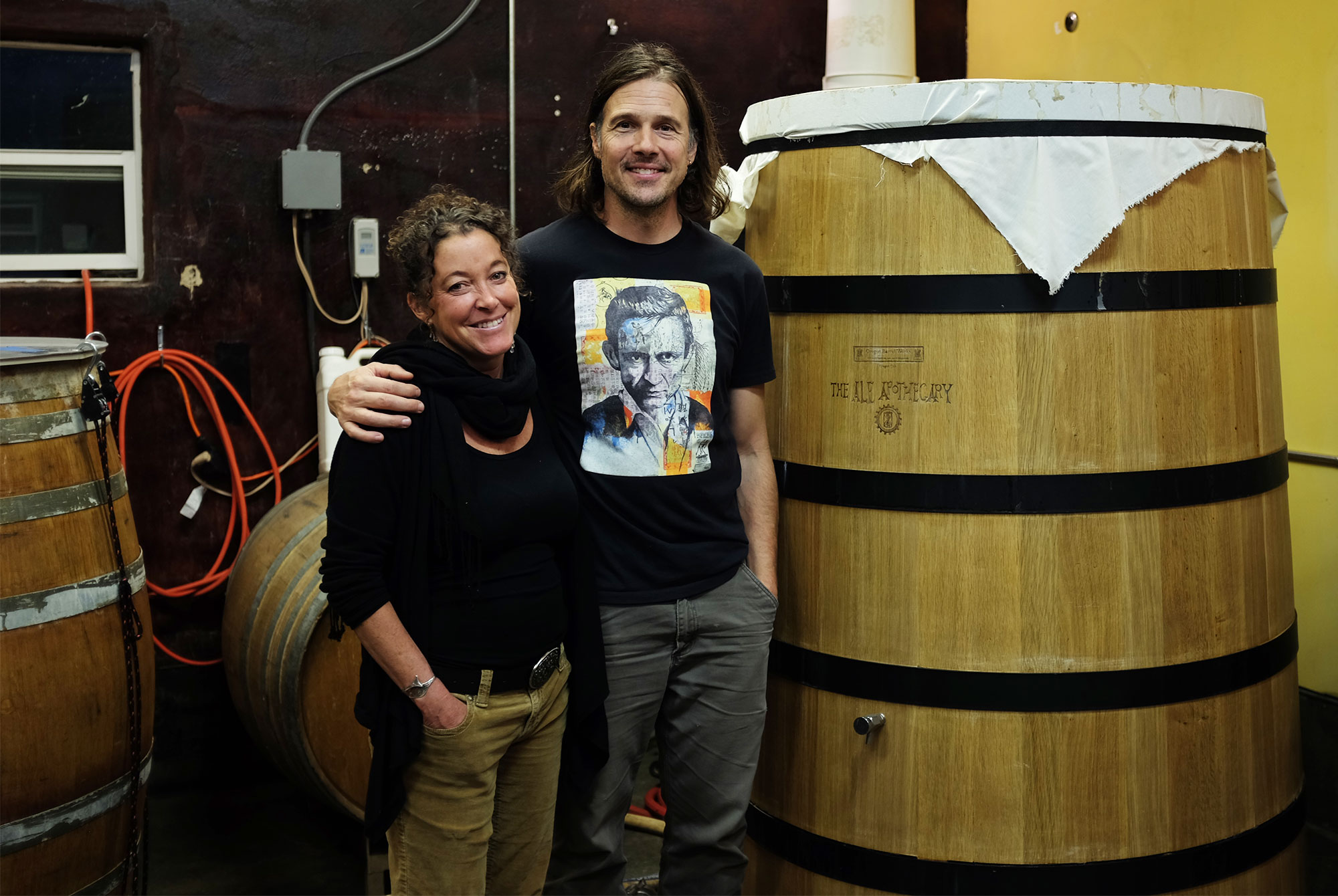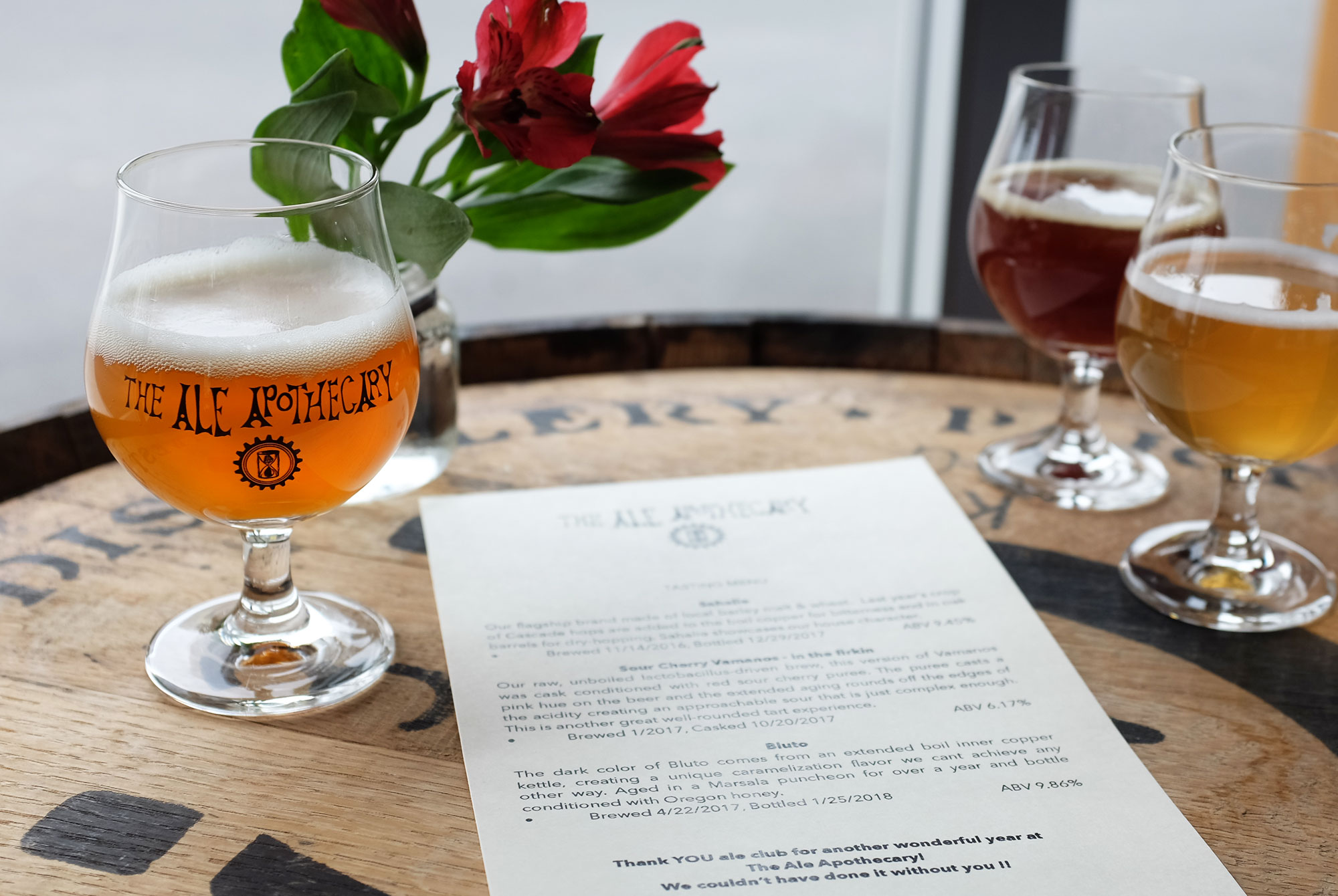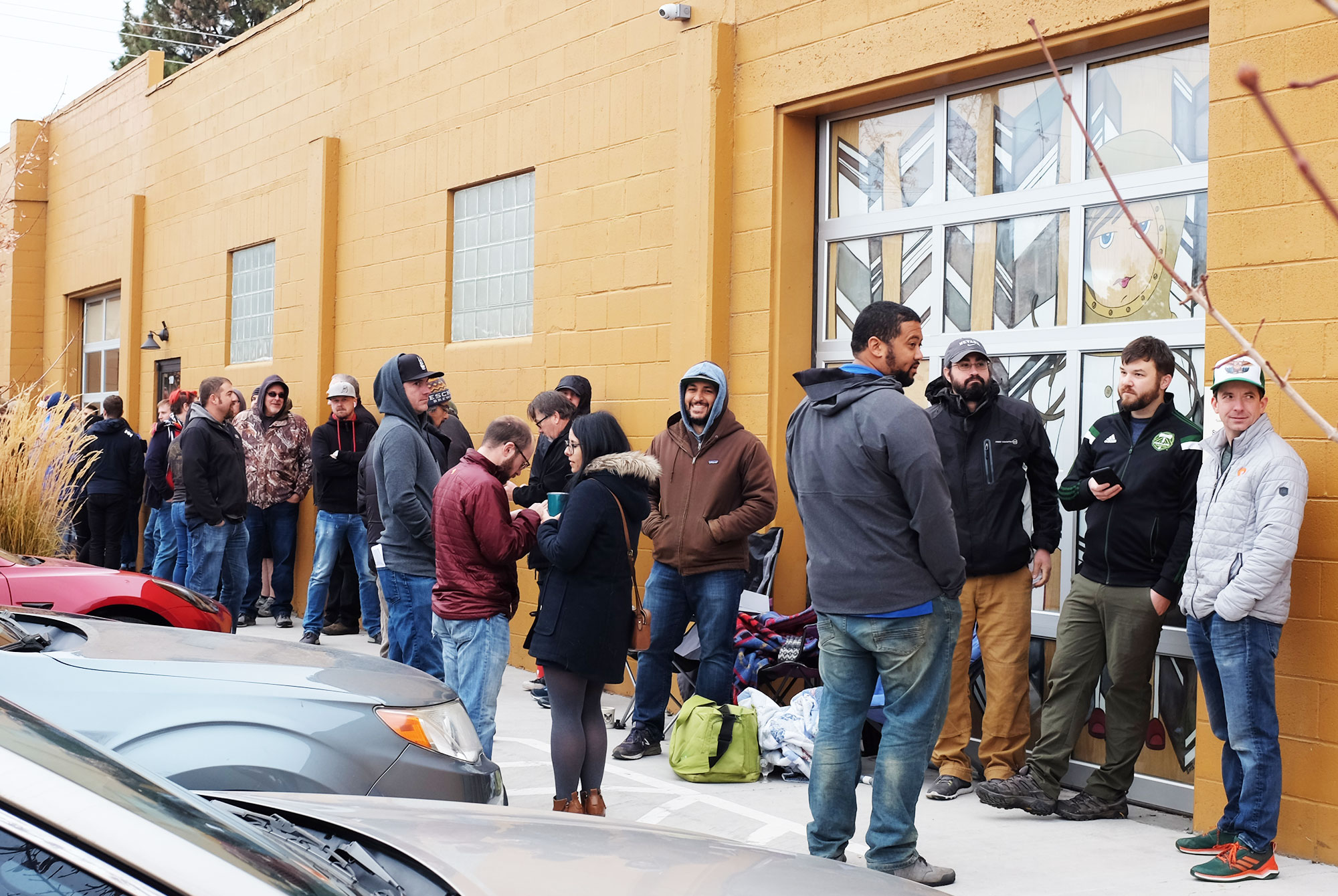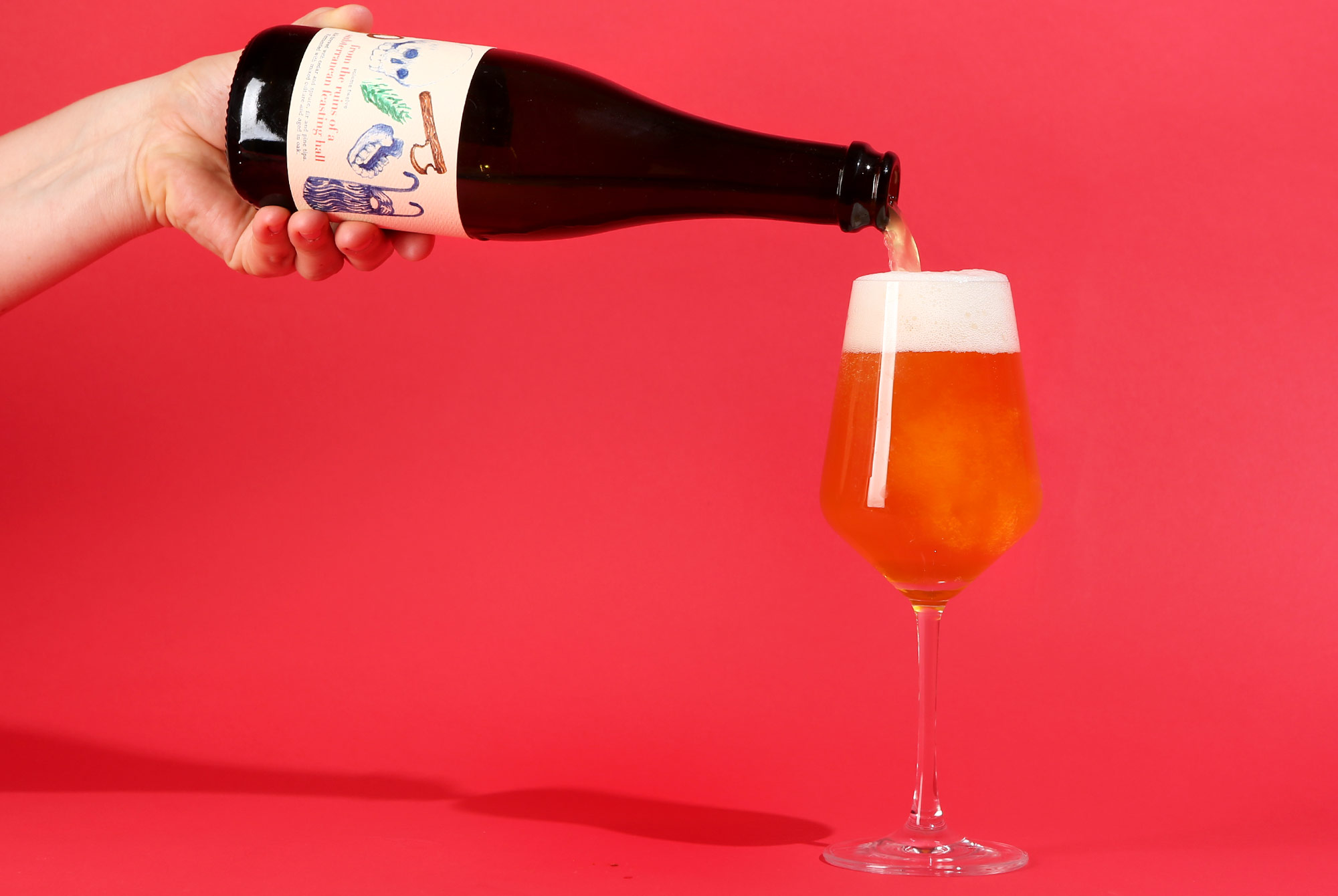Shop
Origin Beer: A Trip To Bend, Oregon, And The Ale Apothecary
Rather than love, than money, than fame, give me truth.
Prior to starting a beer magazine, I worked at an urban farm in Berkeley that donated the majority of its produce to the community. Eventually, time and circumstance brought me back to New York City, but I still have a deep respect for those connected to the earth, who pursue their ideals without compromise. Staci and Paul Arney, owners of The Ale Apothecary in Bend, Oregon, are two of those people.
I’d come to Bend on invitation from Staci, whom I met at Hop Culture’s Brooklyn-based Beers With(out) Beards Festival in August 2018. The single bottle of Fresh Hop Sahalie that Staci and her taproom manager, Kirsten Schopen, brought to the brewer’s bottle share was a crowd favorite, causing more than one person to wax poetic. During the event, Staci dropped a casual invitation to visit the brewery in Bend, and she made good on the invite a few months later when she offered to put me up during The Ale Apothecary’s anniversary.
Honestly, I’m not quite sure why I said yes. In the last year, I’ve turned down invites from friends to events that were much closer in proximity, and much more accessible. Thinking about it now, a part of me definitely wanted an excuse to visit the Pacific Northwest, which I hadn’t seen since I was a teenager. But there was also a sense that The Ale Apothecary was somehow different, the kind of brewery that I could write a few thousand words about without mentioning can release lines, or rare hops, or any of the buzzy factors that define the majority of cool and interesting breweries that Hop Culture covers.
To reach The Ale Apothecary, one flies from Portland to Bend, or better yet, drives the three hours through the Mt. Hood National Forest and the Warm Springs Reservation, marveling as Oregon rain turns to mountain fog and then sunny plains of yellow grass. The forest road that leads to their property is flanked on either side by thick conifers. Every day at dusk, a coyote crosses the road at mile eight. The facility itself is across the street from the Arney’s home, the yard filled with neighborhood children and the Arney’s own offspring, who explore the woods as Staci would’ve during her childhood in Alaska.
I arrived just before sunset, as Paul sealed a foeder and sprayed the floors. The place smelled like grape skins, oak, and fermentation. After a quick tour of their facility, during which Staci showed me the picturesque Tumalo Creek from which the family and brewery get their water, and the ancient truck the Arney’s use to bring barrels from the production facility to the taproom, eight at a time, Paul closed up the brewery and told his story.
The Arneys met in a Calculus I class at Western Washington University, where Staci singled out Paul to be her study partner. In 1996, two weeks after their marriage, the couple moved to Bend for Paul’s new job at Deschutes Brewery. For seven years, Paul worked at Deschutes, and then he and Staci traveled the world for a year and a half. When they returned, they moved right back into their old house, and Paul started working at Deschutes again. He also took advantage of what he calls the “crazy lending period” to secure a loan and buy a piece of property in the Deschutes National Forest, ten miles west of Bend.

“It felt like a very special place,” Paul said, describing the property on which we stood. “It was right on the creek. We’d mountain bike up here and take the dogs.”
It was a peaceful time. As Staci recalls, Paul told her, “I could work at Deschutes forever.”
He made it another four years.
The affable Paul is quick to point out that he loves Deschutes. More than once during our interview, he said something along the lines of, “They’re a great company, and I want to make that very clear.” However, at the time, he was one of three assistant brewmasters, and the head brewer wanted to make sure everyone understood each position. The head brewer asked Paul to work the cellar, to manage budgets and people. That didn’t work for Paul, so he quit.
Having two young kids, a large piece of land in the woods, and no job might stress some people out, but Paul and Staci seemed to handle the situation in stride. Paul had a 401k built up, and with a loan from his dad, he turned his garage into a brewery.
For the first time, Paul had full reign to examine the questions that interested him: What does the craft mean? What does local mean? What is process?
“I like history, and one of the reasons I became a brewer is the idea that beer is something people have made for a very, very long time,” Paul said. “But especially as Americans, we’re missing this connection with history. Industrial Revolution and Prohibition — these are two things that have severed our connection to brewing culture. Lucky for us, in the 1980s craft brewing got started back up and everyone got excited about it. But here I was working at a brewery that was fully considered ‘craft’ and they used an automated brewhouse. You engaged with a computer and everything was very managed and controlled.”
With the time and space to experiment, Paul looked to history to inform his brewery. A thousand years ago, people making beer didn’t use fancy brewing equipment, or a catalogue of ingredients. They had water, and yeast, and whatever they could forage. They also had “creative brewer’s brains” to put those things together in a way that’d be palatable and tasty.
The Ale Apothecary rose from this desire to connect to beer, to dig deep into history and find the roots of brewing culture. Like those who brewed before him, Paul took his ingredients from the surrounding area. He used a manual brewhouse, and his water came from the Tumalo Creek behind his property. He captured yeast from the environment, and his malt and hops all come from Oregon. He forages adjuncts; every year, he personally picks black currants for Spencer, the beer named after his son.

“We’re not brewing sour beer because I want to brew sour beer,” he said. “We’re brewing it because I want to brew a natural product.”
The Ale Apothecary doesn’t make beer for everyone. They craft products in the styles of our ancestors, combining pure, local ingredients to make them tart and naturally complex. On the East Coast, when I’ve seen The Ale Apothecary’s bottles, I’ve always wondered about the $35, $40, or even $80 price tags. But how many other breweries make each beer by hand, on a manual system, with ingredients that they’ve personally foraged? Scratch Brewing, Wunderkammer, and a few others, and the prices of their beer also reflect the labor required to make them.
The frustrating part for Paul is that on the shelf, his beers can look like any other. Without the story, and the connection to a place, a bottle from The Ale Apothecary looks needlessly expensive.
“I’m trying to find a way to help the consumer differentiate,” he said, which is especially important as the beer market becomes more competitive. A market with 2,500 breweries in 2012 now supports over 7,000, with another 2,000 in planning. “We can’t use the word ‘craft,’ and we can’t use the word ‘artisan’ because it’s on Keebler crackers. A friend of mine who makes beer down in St. Helena talks about origin. Origin Beer. Something that’s ‘origin’ based means we know where all the ingredients come from.”
Origin beer. It’s a beautiful, fitting term, and one that perfectly captures the uniqueness of The Ale Apothecary’s products.
But why is it important to make beer like this? That night, I met the Arney’s at Spork, a Mexican-Asian fusion restaurant across the street from my AirBnb. The Arney’s daughter Sahalie was there with a neighborhood friend, as was their son Spencer, and Paul’s dad, who goes by Buzz. We were also joined by Kirsten, The Ale Apothecary’s taproom manager. The staff at Spork were kind, the food was excellent, and the entire restaurant had a bustling sense of community. Everyone knew each other. They shared tables and chairs and asked about each others’ children.
Even those who weren’t in the bottle club knew about The Ale Apothecary’s anniversary, and many of them congratulated Staci and Paul. The farm at which I worked in Berkeley had a similar sense of community. Just like the farm, which supported Berkeley and was in turn supported, people in Bend have a mutually beneficial relationship with The Ale Apothecary. Small breweries that boost their local economies also have relationships with their towns, but The Ale Apothecary’s connections go deeper, into the very land itself, where worms aerate the soil and the roots of blackcurrant plants compete for water.
In practice, this connection translates into some of the most complex beer I’ve ever tasted. Spencer, reserved for Ale Club members, spends close to two years on oak, and contains wild black currants that Paul forages himself. Ralph, my personal favorite, is brewed with fir needles and honey, and tastes like a forest in autumn.

But the connections also seem to have on effect on the brewery’s fan base. The next morning, when I arrived at the brewery on the day of their anniversary, I saw a long line stretched around the building. Great, I thought. Another long bottle release line. But this was different. It was silent. I remembered what Staci had told me the night before.
“Our fans are patient,” she’d said. “You’ll see.”
Later that day, at The Ale Apothecary Bottle Club Share, I met a gentleman from Idaho and found out we shared a mutual friend. I met Emily Carr, a poet and the director of the MFA program at OSU Cascades, who contributed a poem to one of The Ale Apothecary’s bottles. I caught up with a friend from LA that I didn’t know would be there, and two others from Tucson, who I’d met during previous travels.
With the exception of two shady-looking men who crowd around a barrel topped with rare lambics, eyeing anyone who got too close with murderous intent, beer flowed with good humor. Everyone was friendly, an extended branch of the Arney family. I can’t think of a time I’d seen a more patient, kinder bunch of beer fans, and I can’t help but think the beer, the patience, and the kindness arise from The Ale Apothecary’s commitment to culture.
“We’re not brewing sour beer because I want to brew sour beer,” he said. “We’re brewing it because I want to brew a natural product.”
This isn’t to say that every brewery should produce Origin Beer. For one, we’d all be drinking sours, and I’m personally partial to a juicy IPA every now and again. But it definitely means something that I’ve visited hundreds of breweries (and thousands of other small businesses, for that matter) and only experienced a handful of times what I saw at The Ale Apothecary. Their common thread? Connection to place.
Still, I’d like to find more breweries that remind me of the farm where I used to work. Breweries that take advantage of their local ecosystem to craft unique products that connect to a time and place. Breweries that feel strongly about setting a good example for future generations. Is it possible? I’m not sure. But what I saw in Bend, Oregon, gives me hope.
Liked this article? Sign up for our newsletter to get the best craft beer writing on the web delivered straight to your inbox.



